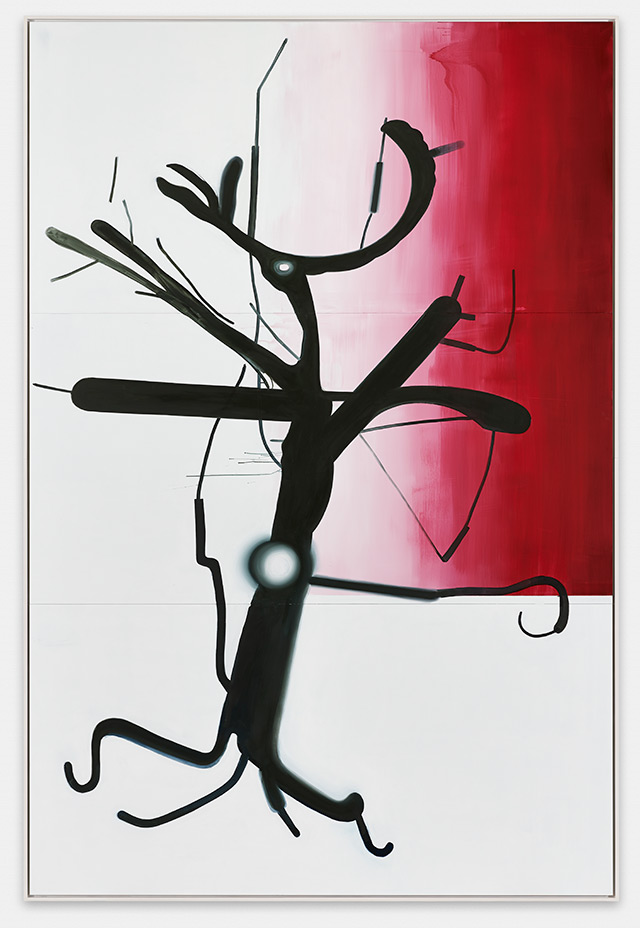
Untitled (Tree 1)
Untitled (Tree 1) [Ohne Titel (Baum 1)], 2013
Oil on Dibond
378 x 250 cm
Private collection, courtesy of Galerie Max Hetzler, Berlin/Paris
Photo: def image
© Albert Oehlen
"[Behind the works revolving around the tree motif is] The thought of what would happen if one interpreted the crazy, chaotic and disorganized formation of the branches as an analogy of the artist in front of the empty canvas, not knowing where his brushstrokes will lead. No detail is fixed, no aspect is fixed." [1] Albert Oehlen, 2015
In the course of his career, Albert Oehlen (b. 1954, Krefeld, Germany) has varied his style and materials, moving from figuration to abstraction, from oil paints to computers, or from canvas to aluminum. But despite the changes in his way of painting and the creative processes he uses, the depiction of trees has been a constant in his oeuvre from the 1980s to the present day.
Oehlen always likes to set certain rules for himself when making art. For his series of Grey paintings, he determined to use only gray paint; in the Bad Paintings series, he limited his palette to red, yellow, and blue; and his Computer Paintings are done in black and white.
Oehlen began his tree series in 1988 with a set of rules: the figures had to be vertical and situated in the center, while the lines should be increasingly narrow as they extended from the midpoint of the tree. [2] His early trees were more figurative, with defined shapes—clearly recognizable trunk, roots, and branches—painted in murky greens, grays, and browns.
Around 2005 the trees became more simplified, losing color and turning into black shapes against a two-tone geometric background. [3] Oehlen also began carefully applying paint to large aluminum-faced polyethylene panels, doing his best to leave no trace of the brush's action. By applying oil paint in this extremely clean, flat way, the artist managed to create trees that look like the digital products of design software. [4] As a result of this particular method, his paintings took on the appearance of advertising panels, even though they were meticulously hand-painted with oils.
From that moment on, Oehlen began to focus more on the development of the branches and roots. Inspired by the chaotic, disorganized formation of the branches and roots on some trees, Oehlen created a more intuitive, impulse-driven work. When he started painting his trees, nothing had been determined beforehand except the colors he would use for figure and ground, predominantly white and magenta.
Preguntas
Before looking at Oehlen’s work, take a pencil and paper and make a rough sketch of a tree. When you’ve finished, compare it with the artist’s painting. How are they similar? How are they different? How would you describe Oehlen’s tree? And yours? What are the clues in Oehlen’s work that tell you the theme of this painting is a tree?
Now look closely at the technique Oehlen used. Untitled (Tree 1) [Ohne Titel (Baum 1)] is hand-painted in oils on an aluminum panel. Observe the artist’s brushstrokes: Why do you think he painted it that way? What effect did he hope to achieve? Do you think he succeeded? Why? Why do you think Oehlen chose these materials? Do you think they’re related to his theme? How are they related? How do you think the support surface affects the work? How would it be different if he had painted it on another material, like wood, canvas, or a wall? What would be different?
Where do you imagine this tree might be planted? In the place you’ve imagined, what are the surroundings like? Would you like to visit that place? Why? What would you see, hear, smell and touch in that place? How would you feel? What time of day do you think it is? Would you climb this tree?
